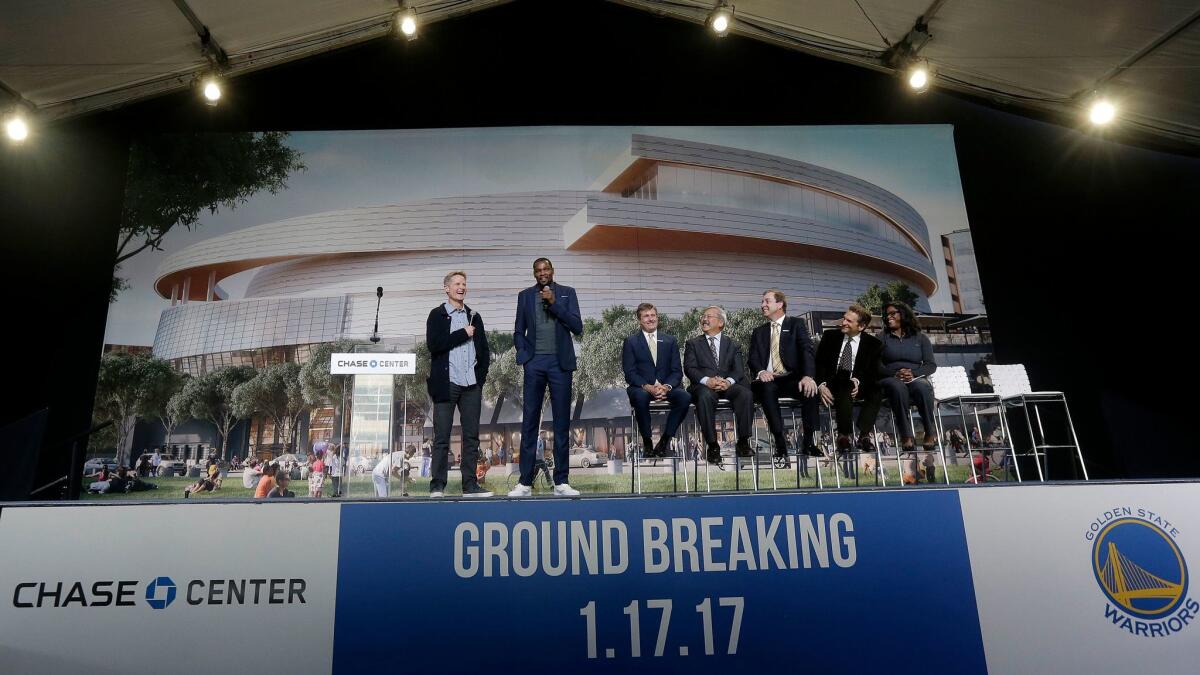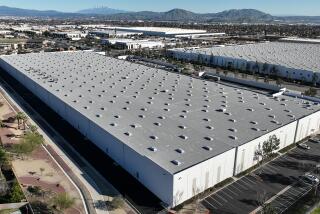A key reform of California’s landmark environmental law hasn’t kept its promises

Reporting from Sacramento — It took until the morning the Golden State Warriors broke ground on their new professional basketball arena in San Francisco last week for the lawsuits against the project to end.
The arena’s future neighbors had filed suit under the state’s primary environmental law governing development, and the team sweated out the case. Rick Welts, the Warriors’ president and chief operating officer, announced to the crowd at the groundbreaking that the state Supreme Court had just rejected a final appeal: “It’s over,” he said.
The Warriors weren’t supposed to wait as long as they did. Under legislation passed in 2011, environmental lawsuits against mega-projects would face significant restrictions, forcing any litigation to take no longer than nine months. Instead, the Warriors’ case lasted nearly a year.
Overhauling the environmental law, the California Environmental Quality Act, is a perennial issue at the Capitol, and the measure benefiting the Warriors arena was one of the most high-profile CEQA reforms in recent years. But the failure of the 2011 legislation to meet its stated goals reveals the difficulty lawmakers have had in making meaningful changes to the law.
Legislators continue time and again to replicate the 2011 law’s provisions in other bills, hoping that housing, water infrastructure and other projects might receive the same benefits. Though the law’s effects have been limited to date, lawmakers who introduced the bills thought it would be politically feasible to get them through the Legislature. So far, however, none have survived.
“Of course, I would like to do more,” said Assemblyman James Gallagher (R-Yuba City), whose legislation to streamline CEQA lawsuits against water projects failed during the last legislative session.
The landmark 1970 environmental legislation is credited with helping to protect the state’s natural beauty, but it is also criticized for stifling development.
Since it passed, the CEQA has been a consideration in how most major projects get approved in California. The law requires the disclosure of any effects a development might have on the environment, an evaluation of alternatives and, in many cases, proposed changes that would reduce those environmental effects to a level of insignificance. Environmentalists praise the law as an indispensable tool in preservation efforts.
But the law reaches into political and policy debates beyond what many might think are purely environmental issues. Lt. Gov. Gavin Newsom said recently the state could use a CEQA lawsuit to try and stop President Trump’s proposed border wall. Labor and environmental groups torpedoed Gov. Jerry Brown’s proposal to spur housing development last year because the organizations believed the measure was an end-run around CEQA rules that would otherwise guarantee more detailed reviews of new homes.
Labor unions have used threats of CEQA lawsuits to leverage labor-friendly hiring rules on developments. Businesses have done the same to challenge their competitors. The law has even been used to block the installation of bike lanes.
The 2011 legislation to reform CEQA, Assembly Bill 900, targeted one of the most common complaints about the environmental law process: It takes too long for lawsuits to make it through the courts.
The legislation said that projects valued at $100 million or more that met renewable energy and greenhouse gas reduction targets, and that provided higher-paying jobs to construction workers, could qualify. The law did not shield the projects from needing to disclose and minimize their environmental impacts under CEQA. Instead they were offered two key perks aimed at resolving any legal claims more quickly: Any CEQA lawsuit against such a project would be routed directly to an appeals court and wrapped up within a tight, nine-month deadline.
But soon after the law’s passage, a local court found the appeals court provision to be unconstitutional. The Warriors arena is the only project since 2011 that has needed to use the streamlined legal time frame, and the case failed to meet the deadline.
“Utterly fake,” said Jennifer Hernandez, an attorney and author of multiple reports critical of CEQA’s effects on development, of the 2011 law’s promises.
Since 2011, seven projects have qualified under the law. Some, such as a proposed football stadium in San Diego, never got off the ground. Others, including the expansion of Apple’s headquarters in Cupertino, weren’t sued.
Even though their CEQA litigation lasted longer than nine months, Warriors officials said they benefited immensely from the law. P.J. Johnston, a spokesman for the arena project, credited the measure for shaving at least two years off the legal timeline the project could have faced otherwise.
“The fact that AB 900 ensured that the case would be heard in a timely fashion weakened that rather cynical weapon that the obstructionists had in their quiver,” Johnston said. “If they couldn’t merely delay the project for years on end, then they had to try to win the case.”
Opponents of the arena, primarily those affiliated with the UC San Francisco hospital neighboring the project, also believe that the quicker legal process affected the case. Osha Meserve, an attorney who litigated against the project, said the timeline makes it difficult for those suing to present all their arguments. That’s especially hard, she said, because the projects in question are so big.
“The overall effect is that AB 900 truncates judicial review of very large projects that should receive the most careful review since they have the most potential to have negative environmental and other impacts,” Meserve said.
The legislation could face another test soon. Four lawsuits have been filed against 8150 Sunset, the Frank Gehry-designed residential and commercial skyscraper along the eastern edge of the Sunset Strip that has qualified for streamlined review and was approved by the Los Angeles City Council last year. A Los Angeles County Superior Court judge recently approved a schedule for the case that aims to meet the nine-month deadline.
Brown, who signed AB 900 and has supported broader changes to CEQA, believes that a quicker time frame proves the law’s worth, even though the deadline for resolving lawsuits hasn’t been met. The bill has been reauthorized multiple times, most recently last year.
“Project proponents continue to apply under the statute, so, clearly, they see value in those provisions,” Brown spokesman Gareth Lacy said.
ALSO
Hollywood skyscrapers are in line for environmental fast-tracking
Development deals tied to state budget sidestep ‘green’ rules
Want a bike lane in your neighborhood? It’s not so simple in California
Updates on California politics
More to Read
Get the L.A. Times Politics newsletter
Deeply reported insights into legislation, politics and policy from Sacramento, Washington and beyond. In your inbox three times per week.
You may occasionally receive promotional content from the Los Angeles Times.











